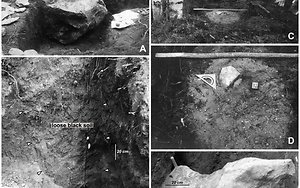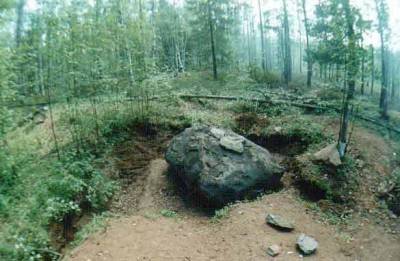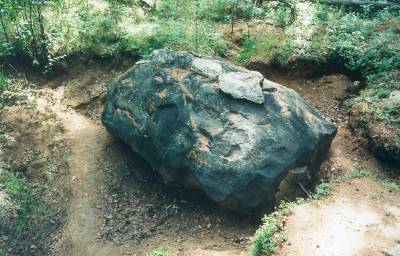- 13.02.2014
- 3493 Просмотра
- Обсудить
The aim of the study was to discover remnants of the 1908 Tunguska meteorite.
Main objective of the field studies was identification of exotic rocks,
furrows, and penetration funnels reported by the first eyewitnesses, residents
of the area with severe forest destruction. Main methods included decoding of
aerial survey photographs, systematic survey of the epicenter area of the
Tunguska explosion, exploratory excavations of the objects of interest,
reconstruction studies of exotic boulder by using its splinters, mineralogical
and spectral analysis of specimens, experimental attempt of plasma-induced
reproduction of the fusion crust on specimen. The authors present results on
discovery of penetration funnel-like structures; exotic boulder (known as
John's Stone)) with its shear-fractured splinters and fresh furrow in the
permafrost; several splinters with glassy coatings; evidence of high-speed
John's Stone deceleration in the permafrost; and clear consistency in geometry
of spacial arrangements of all splinters, furrows, cleaved pebbles according to
data of reconstruction studies. John's Stone is composed of highly silicified
gravelite sandstone (98.5% SiO2) with grain size of 0.5 to 1.5 cm.
Outer surface of several splinters showed continuous glassy coating similar to shiny fusion crust reminiscent of freshly applied enamel. Plasma-induced heating of John's Stone specimen led to its explosive disintegration; residue presented with whitish semi-transparent pumice-like grains and irregularly shaped fused particles. Overall, our data suggest that John's Stone is Tunguska meteorite candidate. Recent discoveries of sedimentary rocks, lithified gravelite sandstone, clay, and quartz on Mars provide rationale for search and identification of silica-rich Martian meteorites of sedimentary origin.
John Anfinogenov, Larisa Budaeva, Dmitry Kuznetsov, Yana Anfinogenova
Outer surface of several splinters showed continuous glassy coating similar to shiny fusion crust reminiscent of freshly applied enamel. Plasma-induced heating of John's Stone specimen led to its explosive disintegration; residue presented with whitish semi-transparent pumice-like grains and irregularly shaped fused particles. Overall, our data suggest that John's Stone is Tunguska meteorite candidate. Recent discoveries of sedimentary rocks, lithified gravelite sandstone, clay, and quartz on Mars provide rationale for search and identification of silica-rich Martian meteorites of sedimentary origin.
John Anfinogenov, Larisa Budaeva, Dmitry Kuznetsov, Yana Anfinogenova
Никто не решился оставить свой комментарий.
Будь-те первым, поделитесь мнением с остальными.
Будь-те первым, поделитесь мнением с остальными.


